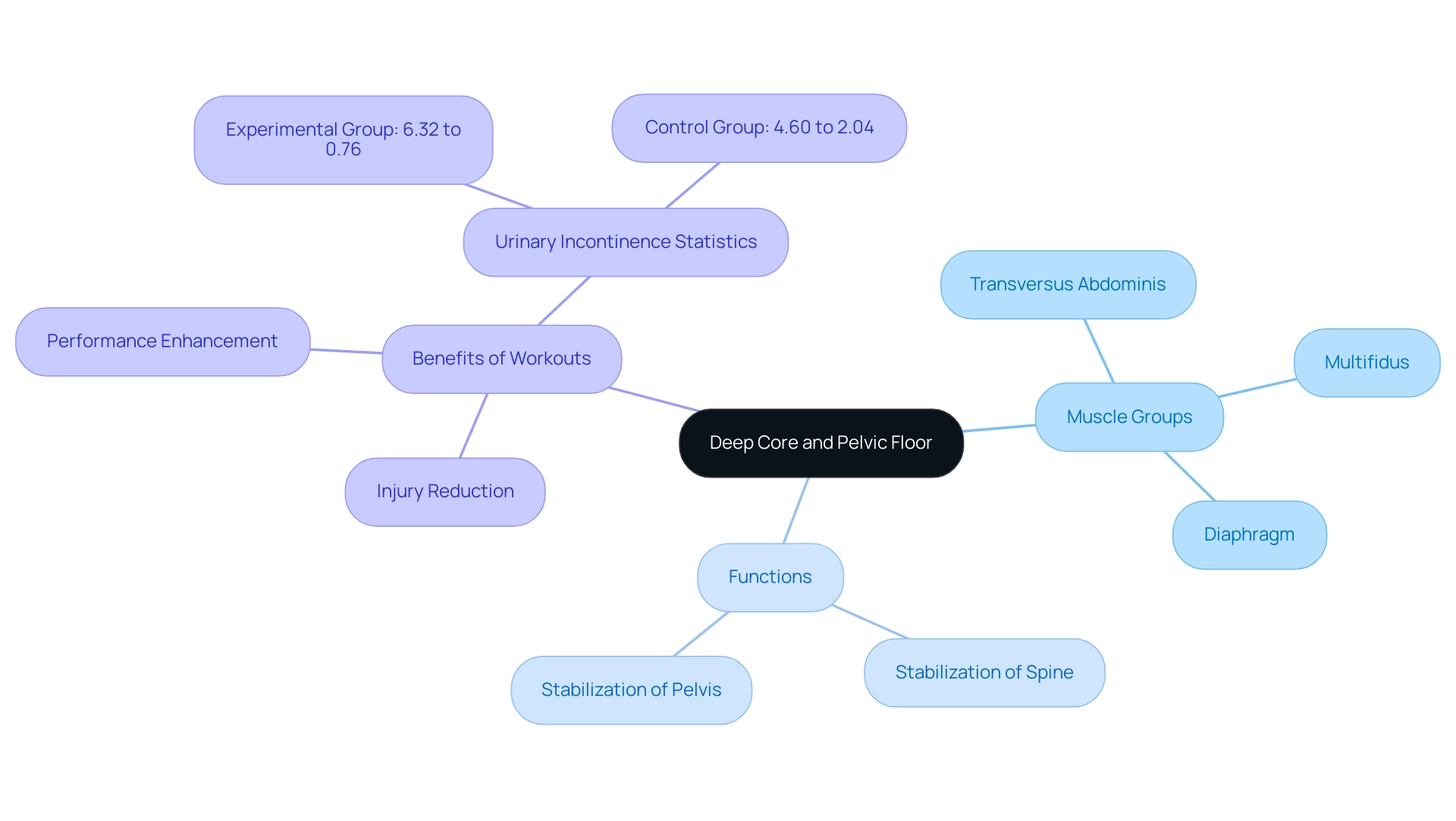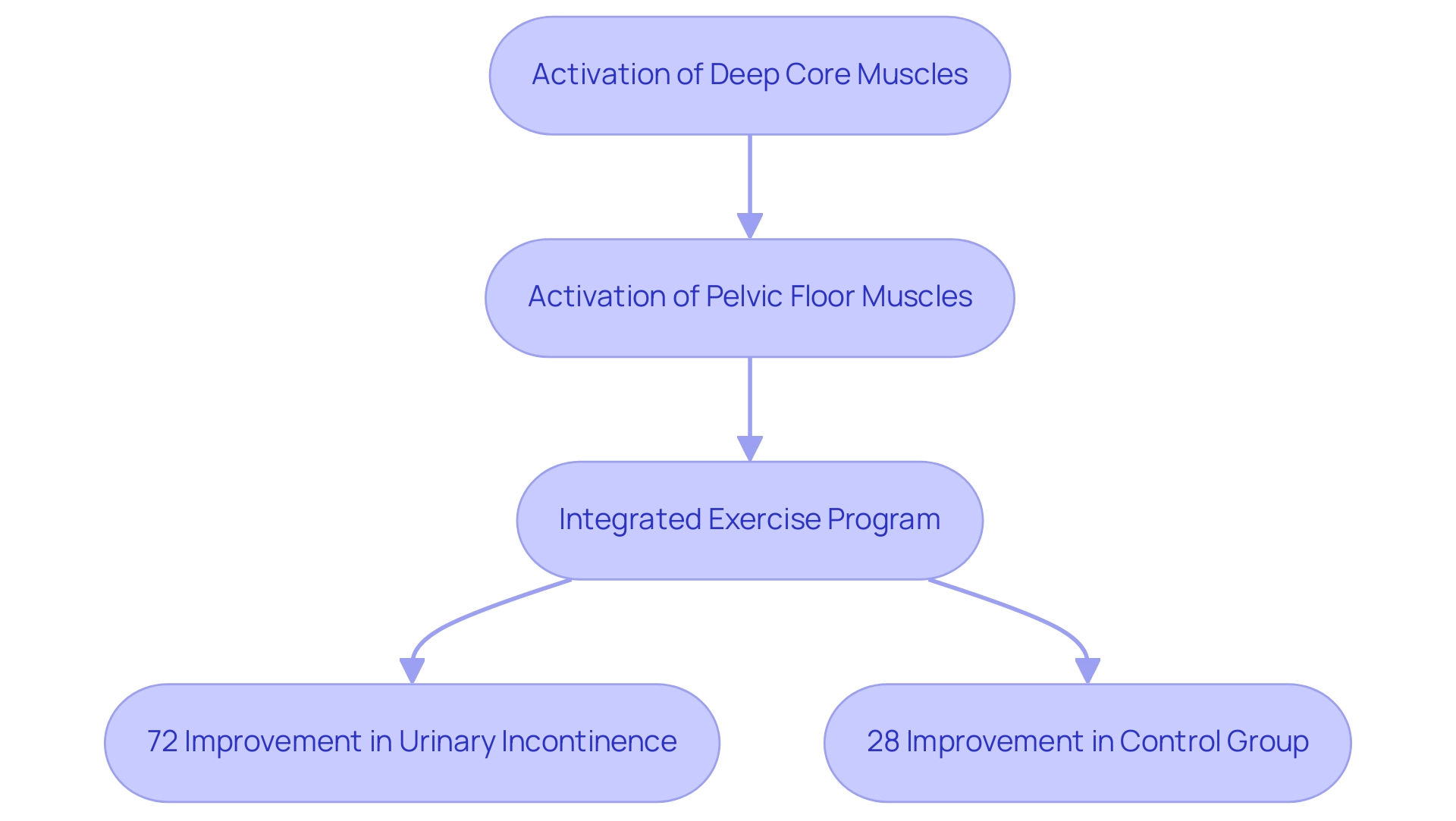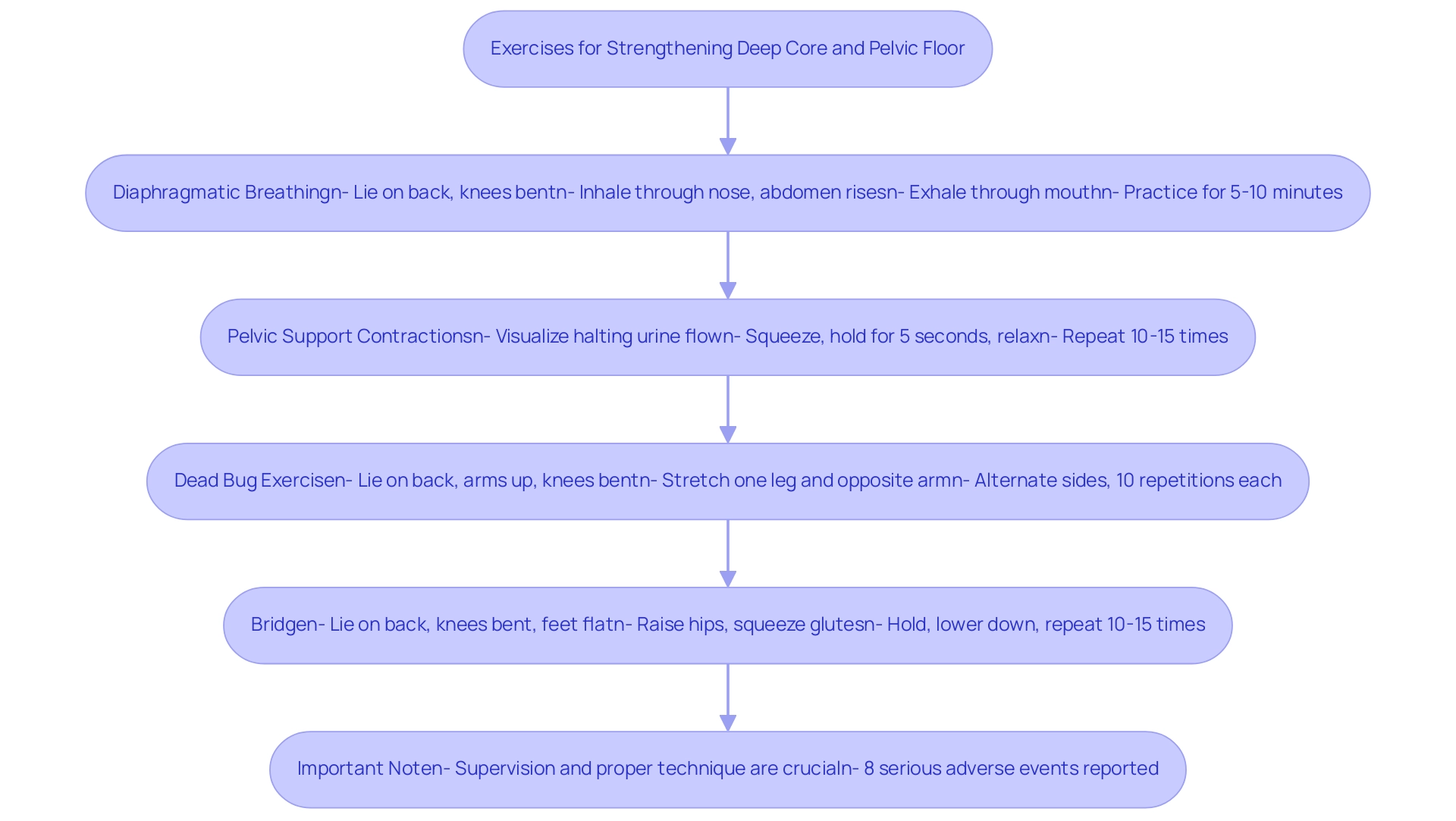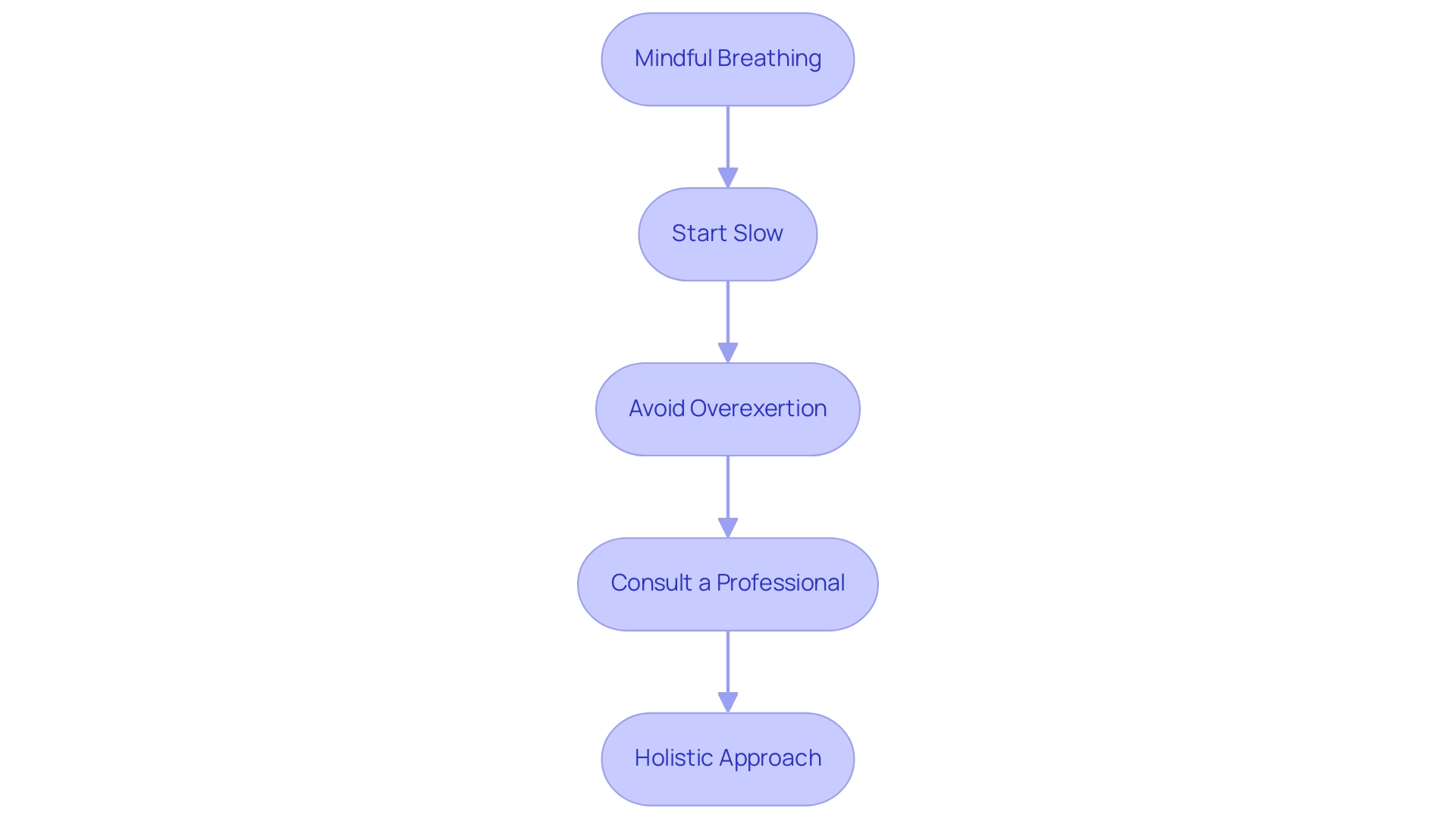Overview
Mastering your deep core and pelvic floor workout involves understanding the interconnectedness of these muscle groups, which significantly enhances stability, posture, and overall well-being. The article highlights that engaging in targeted exercises not only improves physical performance and reduces the risk of incontinence but also contributes to mental health benefits, illustrating the comprehensive advantages of a strong core and pelvic floor.
Introduction
In the quest for optimal health and fitness, understanding the deep core and pelvic floor muscles stands as a fundamental pillar. These interconnected muscle groups not only stabilize the spine and pelvis but also play a crucial role in enhancing overall well-being.
Recent studies have highlighted the transformative impact of strengthening these areas, revealing significant improvements in:
- Daily functioning
- Athletic performance
- Injury prevention
As organizations increasingly recognize the importance of fostering a healthy workforce, integrating knowledge about these muscles into fitness programs can empower teams to achieve greater resilience and vitality.
By exploring effective exercises and best practices for engaging these muscle groups, individuals can unlock a wealth of health benefits that resonate both personally and professionally, paving the way for a more motivated and engaged workplace.
Understanding the Deep Core and Pelvic Floor: Foundations of Fitness
The deep center includes essential tissues like the transversus abdominis, multifidus, and diaphragm, which function together to stabilize your spine and pelvis. Supporting this is the group of tissues that sustains lower body organs and is essential for preserving central stability. Understanding the interplay between these muscle groups is essential not only for establishing a solid fitness foundation but also for enhancing overall well-being with a deep core and pelvic floor workout.
Recent studies suggest that engaging in a deep core and pelvic floor workout greatly enhances your capacity to perform everyday activities, elevate athletic performance, and reduce the risk of injury. For instance, a study revealed that the mean frequency of urinary incontinence in the experimental group dropped from 6.32 to 0.76 after 12 weeks of engaging in specific core stability exercises, while the control group saw a decrease from 4.60 to 2.04. This showcases the direct benefits of strengthening these areas.
As mentioned by Sapsford and Hodges, 'extra abdominal training can enhance core strength,' emphasizing the significance of a comprehensive fitness strategy. By familiarizing yourself with the functions and benefits of these essential groups, you can lay the groundwork for effective deep core and pelvic floor workouts that promote health and vitality. Additionally, a case study evaluating multifidus thickness at the L4–L5 level provided insights into activation patterns, enhancing our comprehension of the support system's function and its significance to stability.

The Interrelationship Between Deep Core Muscles and the Pelvic Floor
The deep center and lower body muscles function together, and activating one frequently stimulates the other. For example, executing a contraction of the lower region, often referred to as a Kegel exercise, can greatly improve the stability provided by your deep core and pelvic floor workout. This interconnection is essential; a deep core and pelvic floor workout reinforces your central muscles, improving overall stability and enhancing lower body function, potentially decreasing the risk of problems such as incontinence.
Recent research underscores the importance of this connection, demonstrating that integrated exercise programs can lead to improved outcomes. High-impact sports like running and gymnastics can weaken the connective tissue supporting the bladder, making it even more essential to strengthen these groups. In a randomized controlled trial titled 'Effects of Core Stability and Pelvic Floor Muscle Exercises on Stress Urinary Incontinence,' 50 women aged 18-60 suffering from stress urinary incontinence (SUI) and nonspecific chronic low back pain (NSCLBP) were divided into two groups.
Individuals who participated in lower body strength exercises alongside a deep core and pelvic floor workout experienced an impressive 72% enhancement in urinary incontinence, compared to only 28% in the control group. Data analysis was performed using intention-to-treat (ITT) analysis and mixed model ANOVA to ensure robust findings. Dr. Hopp, a valued Sports Medicine Physician, supports a holistic approach, stating,
If you are experiencing challenges with engaging or utilizing these tissues, you can consult a specialized therapist who can develop a program tailored to your requirements.
By recognizing and leveraging the interconnectedness of these muscle groups, you can craft a workout that maximizes effectiveness and promotes overall well-being.

Effective Exercises for Strengthening Your Deep Core and Pelvic Floor
To empower your team and enhance overall well-being, consider integrating these effective exercises designed to strengthen deep core and pelvic floor muscles:
- Diaphragmatic Breathing: Begin by lying on your back with your knees bent. Place one hand on your chest and the other on your abdomen. Inhale deeply through your nose, allowing your abdomen to rise while keeping your chest still. Exhale slowly through your mouth. Aim to practice this for 5-10 minutes, as this technique not only calms the mind but also supports core engagement.
- Pelvic Support Contractions: Whether sitting or lying down comfortably, visualize halting the flow of urine to engage your pelvic support tissues. Squeeze firmly, hold for 5 seconds, and then relax. Repeat this exercise 10-15 times to reinforce muscle strength that is crucial for stability and overall health.
- Dead Bug Exercise: Lie on your back with arms raised toward the ceiling and knees bent at a 90-degree angle. Gently stretch one leg and the opposite arm towards the ground while keeping a flat back. Return to the starting position and alternate sides, performing 10 repetitions on each side. This exercise enhances coordination and central control, vital for effective movement.
- Bridge: In a supine position with knees bent and feet flat on the ground, raise your hips towards the ceiling, squeezing your glutes and activating your abdominal muscles. Hold for a few seconds before lowering back down. Repeat for 10-15 repetitions. This action not only enhances the lower abdomen support but also encourages improved posture and stability.
While these exercises can significantly enhance strength and stability in your lower body, incorporating a deep core and pelvic floor workout is essential to approach them with awareness. Recent studies have reported 8 serious adverse events related to support training (PFMT), with 6 occurring in the biofeedback PFMT group. This highlights the importance of proper technique and supervision in these workouts.
As D. Gahreman states, "supervision, project development, data analysis, manuscript editing" are critical components in ensuring the safety and effectiveness of these exercises.
Furthermore, a systematic review titled "Long-term Efficacy of PFMT" found that while PFMT significantly improves symptoms and quality of life, especially in mild cases of urinary incontinence, further research is required to determine the optimal exercise types and durations for different incontinence types. Let these techniques guide your team towards a healthier, more resilient future.

Best Practices for Engaging Your Pelvic Floor During Workouts
To effectively engage your core region during workouts and harness the full benefits of your exercise routine, consider these best practices:
-
Mindful Breathing: Emphasizing the connection between breath and physical engagement is crucial. As you breathe in deeply, concentrate on expanding your lungs, and as you breathe out, intentionally activate your lower body muscles. This mindful approach not only enhances activation of strength but also fosters a sense of control and awareness.
Start Slow: For those new to core exercises, beginning with low-impact activities such as walking or yoga is advisable. These foundational workouts allow you to build strength and confidence before gradually introducing more intense exercises into your regimen. A cross-sectional study assessing the thickness of abdominal muscles found that consistent engagement of these muscles can lead to improved overall strength and stability.
-
Avoid Overexertion: It's crucial to refrain from forcing contractions of the lower abdomen. Instead, prioritize gentle, controlled movements. Listening to your body is essential; this will help you avoid strain and promote a sustainable exercise practice.
-
Consult a Professional: If you feel unsure about how to properly engage your lower abdominal muscles, seeking guidance from a fitness expert or physical therapist specializing in core health can be invaluable. Physical therapists skilled in core muscle training can offer structured therapy for improved outcomes, guaranteeing that you are practicing efficiently and securely.
Holistic Approach: Consider incorporating elements from Comprehensive Floor Therapy, which presents a holistic approach that includes exercises, relaxation techniques, and lifestyle modifications to address health issues. Such therapy can lead to improved bladder and bowel control, reduced discomfort in the lower abdomen, and enhanced sexual function.
Incorporating these best practices not only helps in effectively engaging your lower body during a deep core and pelvic floor workout but also supports overall health in that region. As Dr. Ingrid E. Nygaard eloquently states,
The existing literature suggests that most physical activity does not harm the lower body and does provide numerous health benefits for women.
By prioritizing these techniques, you contribute positively to your own well-being and set a powerful example for your team.

The Health Benefits of Mastering Your Deep Core and Pelvic Floor
Mastering your deep core and pelvic floor workout unlocks a wealth of health benefits that can transform both personal and professional lives. Consider the following advantages, which not only enhance individual well-being but also contribute to a motivated and engaged workplace:
- Improved Posture: A strong deep center acts as a natural support system for proper spinal alignment. This not only mitigates the risk of back pain but also enhances your overall posture, leading to a more confident presence. Research published in the journal of Preventive Medicine indicates that a sample size of 41 participants was required to detect significant differences in strength training studies, underscoring the importance of these workouts.
- Enhanced Stability: By fortifying these essential groups, you significantly increase stability during various physical activities. This improvement translates into better performance in sports and everyday tasks, allowing you to navigate your environment with ease and assurance. A case study titled 'Strengthening and Fall Prevention in Older Adults' shows that engaging in stability exercises can significantly reduce fall-related problems in this demographic, helping them overcome the fear of falling.
- Improved Pelvic Well-being: Engaging the lower body muscles plays a crucial role in preventing issues such as incontinence and organ prolapse. These proactive measures contribute to long-term health and well-being, fostering a sense of empowerment.
- Enhanced Assurance: As you advance in fortifying your central region and lower body, you’ll likely notice an improvement in body awareness and self-assurance in your physical abilities. This newfound strength can inspire you to take on new challenges, both inside and outside the gym, contributing to a more motivated work attitude.
- Stress Relief: Engaging in a deep core and pelvic floor workout not only strengthens your body but also serves as a powerful remedy for stress. Regular exercise has been shown to enhance mental well-being, creating a harmonious balance between work and personal life, ultimately leading to improved workplace performance. Studies from “Workplace Health & Safety” further support that employees who participate in workplace exercise programs report feeling more motivated and engaged, leading to a reduction in absenteeism and presenteeism.
As Sarah Walls, a personal trainer and owner of Strength & Performance Training, Inc., explains, "You get a lot of these core exercises where there’s no spinal movement — or very little — depending on what you’re doing." Committing to these workouts can lead to a healthier, more active lifestyle that enriches both your personal and professional experiences. By embracing these workouts, you’re not only investing in your health but also in the well-being and productivity of your team.

Conclusion
Mastering the deep core and pelvic floor muscles is not just a path to personal fitness; it is a vital investment in overall well-being that reverberates throughout the workplace. Strengthening these interconnected muscle groups enhances daily functioning, boosts athletic performance, and significantly reduces the risk of injuries. The evidence presented shows remarkable improvements, such as the substantial reduction in urinary incontinence through targeted exercises, highlighting the profound impact that a focused fitness regimen can have on health.
Integrating effective exercises like:
- Diaphragmatic breathing
- Pelvic floor contractions
- The dead bug exercise
into daily routines can empower individuals to unlock their potential. Moreover, adopting best practices for engaging these muscles ensures that workouts are both safe and effective, fostering a culture of health and resilience within teams. By prioritizing pelvic health and core stability, organizations can cultivate a motivated workforce that is better equipped to face challenges, both physically and mentally.
The benefits extend beyond the individual, creating a ripple effect that enhances workplace dynamics. Improved posture, stability, and confidence contribute to a more engaged and productive team, while the stress-relieving properties of these workouts promote a harmonious balance between work and personal life. As the understanding of the importance of these muscle groups grows, so too does the opportunity to foster a healthier, more dynamic environment. Now is the time to embrace this knowledge and take action, leading to a brighter and more resilient future for everyone involved.
Frequently Asked Questions
What are the essential tissues involved in the deep core and pelvic floor?
The essential tissues include the transversus abdominis, multifidus, and diaphragm, which work together to stabilize the spine and pelvis.
Why is understanding the interplay between these muscle groups important?
Understanding the interplay is crucial for establishing a solid fitness foundation and enhancing overall well-being through effective deep core and pelvic floor workouts.
How do deep core and pelvic floor workouts benefit everyday activities and athletic performance?
Engaging in these workouts enhances the ability to perform everyday activities, improves athletic performance, and reduces the risk of injury.
What evidence supports the benefits of strengthening the deep core and pelvic floor?
A study showed that the mean frequency of urinary incontinence dropped significantly in individuals engaging in specific core stability exercises over 12 weeks.
What is the significance of extra abdominal training?
Extra abdominal training can enhance core strength, highlighting the importance of a comprehensive fitness strategy.
How do deep core and pelvic floor muscles interact during exercise?
Activating the lower body muscles, such as during Kegel exercises, can improve the stability provided by deep core and pelvic floor workouts, reinforcing overall stability.
What does recent research indicate about integrated exercise programs?
Integrated exercise programs that include both deep core and pelvic floor workouts can lead to improved outcomes, particularly for conditions like stress urinary incontinence.
What were the results of the randomized controlled trial on core stability and pelvic floor muscle exercises?
Participants who combined lower body strength exercises with deep core and pelvic floor workouts experienced a 72% improvement in urinary incontinence, compared to only 28% in the control group.
What should individuals do if they have difficulty engaging these muscle groups?
Individuals experiencing challenges should consult a specialized therapist who can develop a tailored program to meet their needs.
How can recognizing the interconnectedness of these muscle groups enhance workout effectiveness?
By understanding how these muscle groups work together, individuals can create a workout that maximizes effectiveness and promotes overall well-being.

